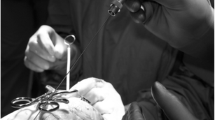Abstract
Purpose
Shunt obstruction is the most common shunt complication. In 2003, Kehler et al. used peel-away sheath while implanting the ventricular catheter in 20 patients. They found less revision rate in the peel-away sheath group. We aimed to test the efficacy of this technique in cadavers.
Methods
We used 100 fresh brains obtained from medicolegal autopsies. Posterior parietal and frontal approaches were used to puncture the lateral ventricle in each cerebral hemisphere. The ventricle is punctured with a peel-away sheath system. After the ventricle is reached, the mandarin is retracted and the ventricular catheter is introduced through the opening. The ventricular catheter was removed from the ventricle, the opening at the tip of the ventricular catheter was checked out for obstruction, and the number of patent and plugged openings was recorded. This procedure was repeated four times for each location with and without using peel-away sheath. The control group consisted of the procedures done without using peel-away sheath.
Results
The number of the plugged openings in the peel-away sheath group was significantly smaller than the control group. There was no significant difference between the two groups in terms of gender and left and right cerebral hemispheres. The obstruction rate was significantly lower in the posterior parietal approach. Pearson’s correlation showed that increasing age was associated with less obstruction rate.
Conclusion
Peel-away sheath decreases the number of plugged openings of the ventricular catheter. A clinical cooperative study is needed to prove that a peel-away sheath should be included in the ventricular shunt systems in the market.




Similar content being viewed by others
References
Aboitiz F, Rodriguez E, Olivares R, Zaidel E (1996) Age-related changes in fibre composition of the human corpus callosum: sex differences. NeuroReport 7:1761–1764
Albright AL, Haines SJ, Taylor FH (1988) Function of parietal and frontal shunts in childhood hydrocephalus. J Neurosurg 69:883–886
Bartzokis G (2004) Age-related myelin breakdown: a developmental model of cognitive decline and Alzheimer’s disease. Neurobiol Aging 25:5–18
Bierbrauer KS, Storrs BB, McLone DG, Tomita T, Dauser R (1990) A prospective, randomized study of shunt function and infection: a function of shunt placement. Pediatr Neurosurg 16:287–291
Collins P, Hockley A, Woollam D (1978) Surface ultrastructure of tissues occluding ventricular catheters. J Neurosurg 48:609–613
Courchesne E, Chisum HJ, Townsend J, Cowles A, Covington J, Egaas B, Harwood M, Hinds S, Press GA (2000) Normal brain development and aging: quantitative analysis at in vivo MR imaging in healthy volunteers. Radiology 216:672–682
Dicker RD, McMonarty WJ, Morgan J, Stevens QE, Jolley JT, Schneider S, Mitler MA (2005) Failure rate of frontal versus parietal approaches for proximal catheter placement in ventriculo-peritoneal shunts: revisited. J Clin Neuroscience 12:781–783
Drake JM, Kestle JR, Milner R, Cinalli G, Boop F, Piatt J Jr, Haines S, Schiff SJ, Cochrane DD, Steinbok P, MacNeil N (1998) Randomized trial of cerebrospinal fluid shunt valve design in pediatric hydrocephalus. Neurosurgery 43:294–303
Ge Y, Grossman RI, Babb JS, Rabin ML, Mannon LJ, Kolson DL (2002) Age-related total gray matter and white matter changes in normal adult brain: part I. Volumetric MR imaging analysis. Am J Neuroradiol 23:1327–1333
Giedd J (1999) Brain development: IX. Human brain growth. Am J Psychiatry 156:4
Kehler U, Klöhn A, Heese O, Gliemroth J (2006) Hydrocephalus therapy: reduction of shunt occlusions using a peel-away sheath. Clin Neurol Neurosurg 105:253–255
Kestle J, Drake J, Milner R, Sainte-Rose C, Cinalli G, Boop F, Piatt J, Haines S, Schiff S, Cochrane D, Steinbok P, MacNeil N (2000) Long-term follow-up data from the Shunt Design Trial. Pediatr Neurosurg 33:230–236
Kestle JRW, Drake JM, Cochrane DD, Milner R, Walker ML, Abbott R 3rd, Boop FA (2003) Lack of benefit of endoscopic ventriculoperitoneal shunt insertion: a multicenter randomized trial. J Neurosurg 98:284–290
Marner L, Nyengaard JR, Tang Y, Pakkenberg B (2003) Marked loss of myelinated nerve fibers in the human brain with age. J Comp Neurol 462:144–152
Meier-Ruge W, Ulrich J, Bruhlmann M, Meier E (1992) Age-related white matter atrophy in the human brain. Ann N Y Acad Sci 673:260–269
Piatt JH, Carlson CV (1993) A search for determinants of cerebrospinal fluid shunt survival: retrospective analysis of a 14-year institutional experience. Pediatr Neurosurg 19:233–242
Rad MH, Vahedi P, Shoeibi A (2005) Cerebrospinal fluid shunt complications. A 10-year study of etiologies and cerebrospinal fluid characteristics. Neurosurg Q 15:1–4
Raz N, Rodrigue KM (2006) Differential aging of the brain: patterns, cognitive correlates and modifiers. Neurosci Biobehav Rev 30:730–748
Sack I, Beierbach B, Wuerfel J, Klatt D, Hamhaber U, Papazoglou S, Martus P, Braun J (2009) The impact of aging and gender on brain viscoelasticity. Neuroimage 6:652–657
Sainte-Rose C (1993) Shunt obstruction: a preventable complication? Pediatr Neurosurg 19:156–164
Tang Y, Nyengaard JR (1997) A stereological method for estimating the total length and size of myelin fibers in human brain white matter. J Neurosci Methods 73:193–200
Tuli S, Drake J, Lawless J, Wigg M, Lamberti-Pasculli M (2000) Risk factors for repeated cerebrospinal shunt failures in pediatric patients with hydrocephalus. J Neurosurg 92:31–38
Author information
Authors and Affiliations
Corresponding author
Rights and permissions
About this article
Cite this article
Çamlar, M., Ersahin, Y., Özer, F.D. et al. Can using a peel-away sheath in shunt implantation prevent ventricular catheter obstruction?. Childs Nerv Syst 27, 295–298 (2011). https://doi.org/10.1007/s00381-010-1226-7
Received:
Accepted:
Published:
Issue Date:
DOI: https://doi.org/10.1007/s00381-010-1226-7




